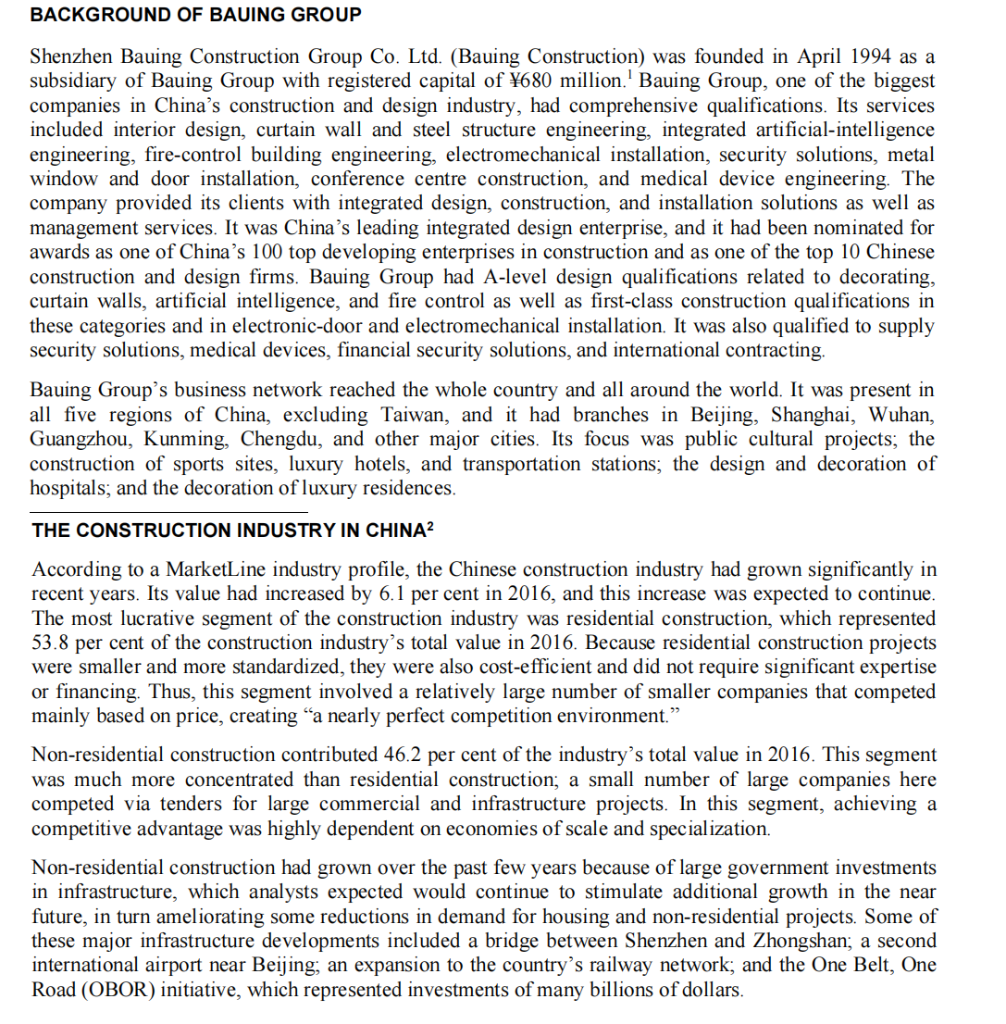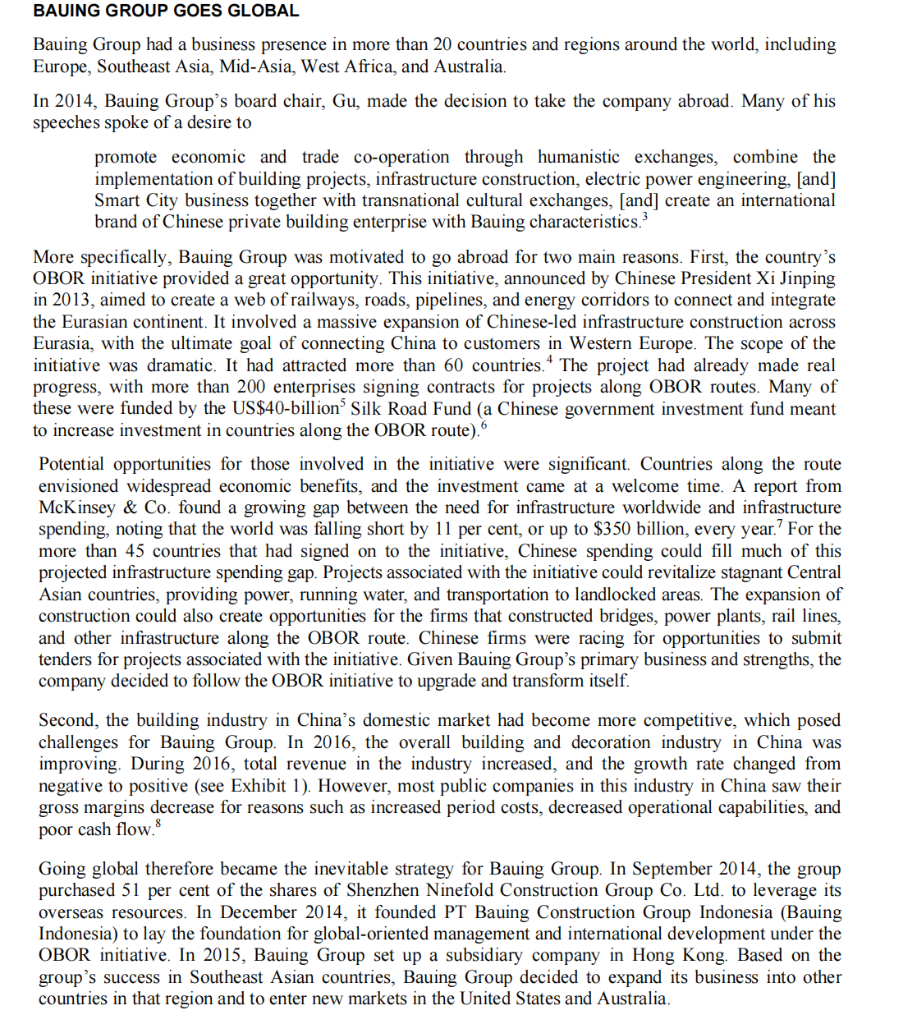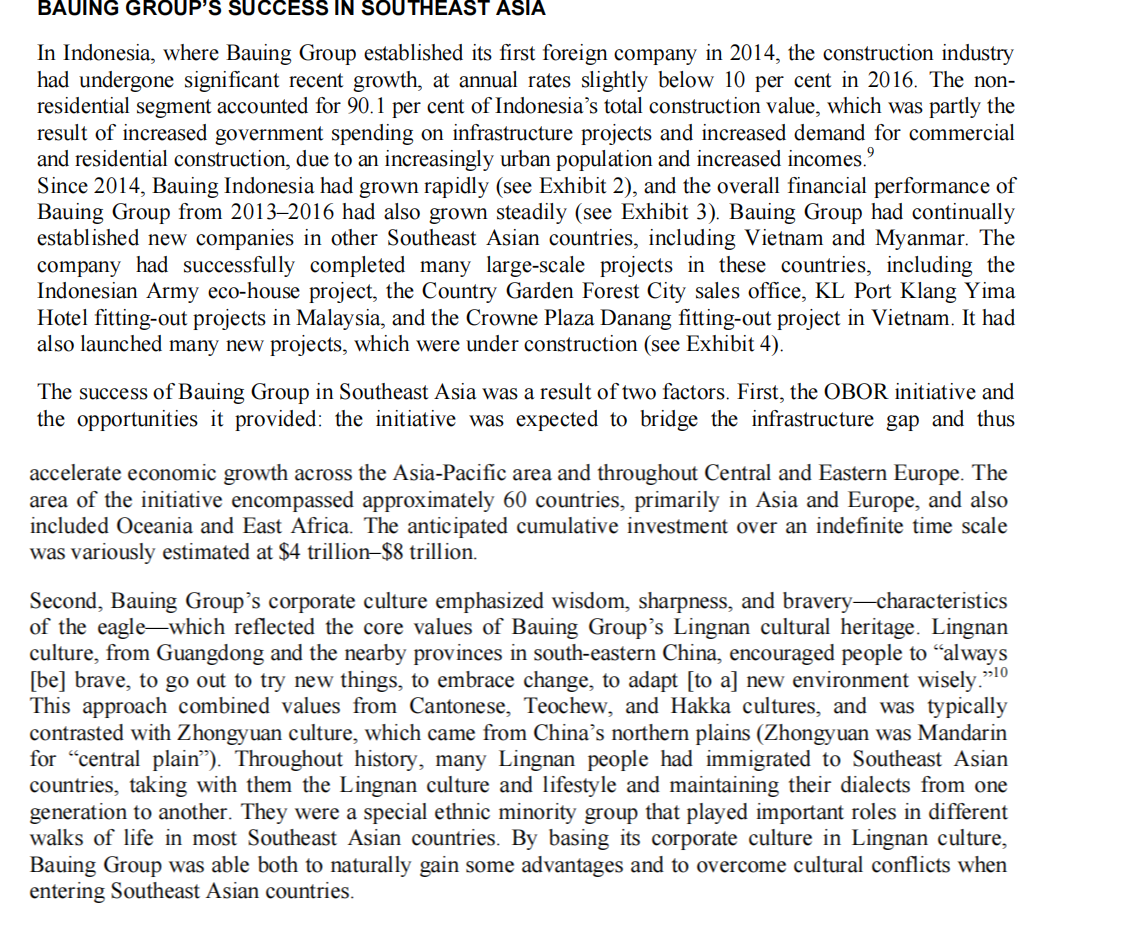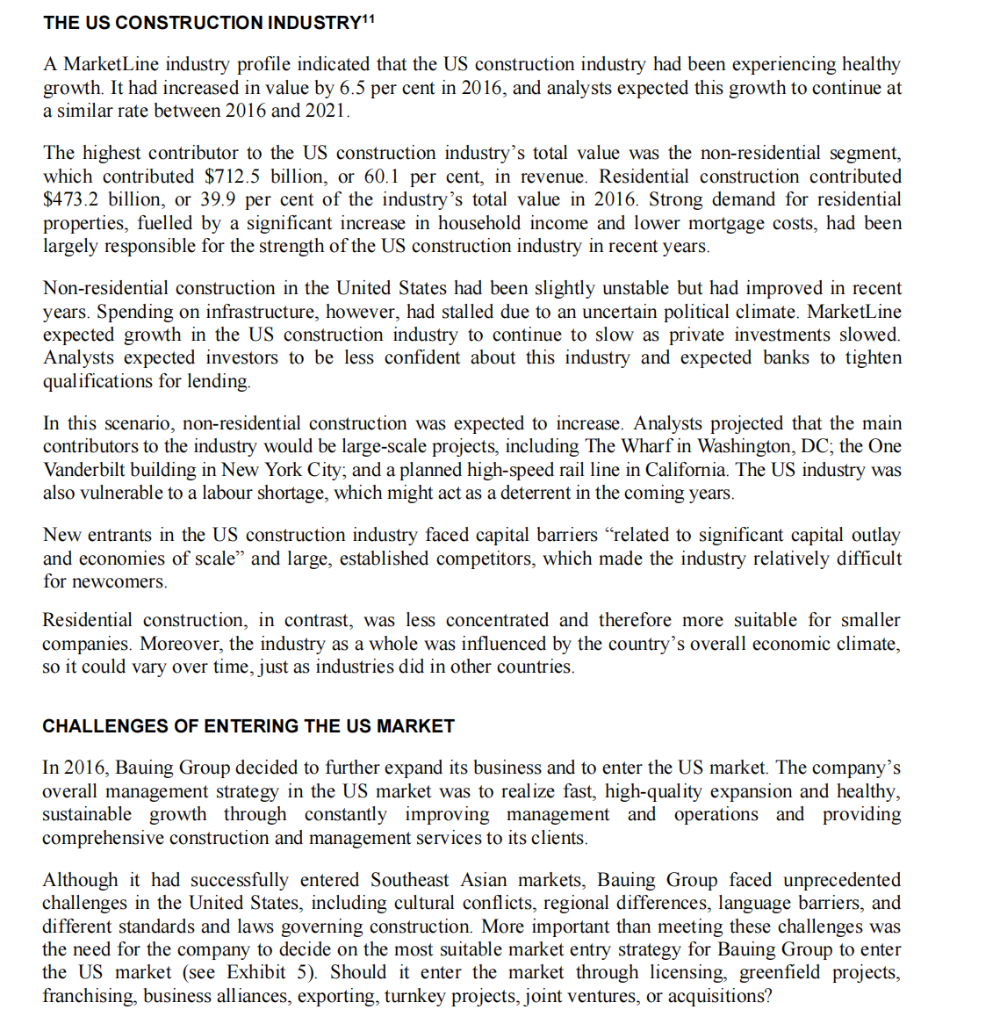Answered step by step
Verified Expert Solution
Question
1 Approved Answer
Based on the case, identify the customer segments, value propositions, revenue streams and distribution channels of Bauing Construction Group BACKGROUND OF BAUING GROUP Shenzhen Bauing




Based on the case, identify the customer segments, value propositions, revenue streams and distribution channels of Bauing Construction Group
BACKGROUND OF BAUING GROUP Shenzhen Bauing Construction Group Co. Ltd. (Bauing Construction) was founded in April 1994 as a subsidiary of Bauing Group with registered capital of 680 million. Bauing Group, one of the biggest companies in China's construction and design industry, had comprehensive qualifications. Its services included interior design, curtain wall and steel structure engineering, integrated artificial-intelligence engineering, fire-control building engineering, electromechanical installation, security solutions, metal window and door installation, conference centre construction, and medical device engineering. The company provided its clients with integrated design, construction, and installation solutions as well as management services. It was China's leading integrated design enterprise, and it had been nominated for awards as one of China's 100 top developing enterprises in construction and as one of the top 10 Chinese construction and design firms. Bauing Group had A-level design qualifications related to decorating, curtain walls, artificial intelligence, and fire control as well as first-class construction qualifications in these categories and in electronic-door and electromechanical installation. It was also qualified to supply security solutions, medical devices, financial security solutions, and international contracting. Bauing Group's business network reached the whole country and all around the world. It was present in all five regions of China, excluding Taiwan, and it had branches in Beijing, Shanghai, Wuhan, Guangzhou, Kunming, Chengdu, and other major cities. Its focus was public cultural projects; the construction of sports sites, luxury hotels, and transportation stations; the design and decoration of hospitals; and the decoration of luxury residences. THE CONSTRUCTION INDUSTRY IN CHINA 2 According to a MarketLine industry profile, the Chinese construction industry had grown significantly in recent years. Its value had increased by 6.1 per cent in 2016, and this increase was expected to continue. The most lucrative segment of the construction industry was residential construction, which represented 53.8 per cent of the construction industry's total value in 2016 . Because residential construction projects were smaller and more standardized, they were also cost-efficient and did not require significant expertise or financing. Thus, this segment involved a relatively large number of smaller companies that competed mainly based on price, creating "a nearly perfect competition environment." Non-residential construction contributed 46.2 per cent of the industry's total value in 2016 . This segment was much more concentrated than residential construction; a small number of large companies here competed via tenders for large commercial and infrastructure projects. In this segment, achieving a competitive advantage was highly dependent on economies of scale and specialization. Non-residential construction had grown over the past few years because of large government investments in infrastructure, which analysts expected would continue to stimulate additional growth in the near future, in turn ameliorating some reductions in demand for housing and non-residential projects. Some of these major infrastructure developments included a bridge between Shenzhen and Zhongshan; a second international airport near Beijing; an expansion to the country's railway network; and the One Belt, One Road (OBOR) initiative, which represented investments of many billions of dollars. Smart City business together with transnational cultural exchanges, [and] create an international brand of Chinese private building enterprise with Bauing characteristics. 3 More specifically, Bauing Group was motivated to go abroad for two main reasons. First, the country's OBOR initiative provided a great opportunity. This initiative, announced by Chinese President Xi Jinping in 2013, aimed to create a web of railways, roads, pipelines, and energy corridors to connect and integrate the Eurasian continent. It involved a massive expansion of Chinese-led infrastructure construction across Eurasia, with the ultimate goal of connecting China to customers in Western Europe. The scope of the initiative was dramatic. It had attracted more than 60 countries. 4 The project had already made real progress, with more than 200 enterprises signing contracts for projects along OBOR routes. Many of these were funded by the US $40-billion 5 Silk Road Fund (a Chinese government investment fund meant to increase investment in countries along the OBOR route). 6 Potential opportunities for those involved in the initiative were significant. Countries along the route envisioned widespread economic benefits, and the investment came at a welcome time. A report from McKinsey \& Co. found a growing gap between the need for infrastructure worldwide and infrastructure spending, noting that the world was falling short by 11 per cent, or up to $350 billion, every year. 7 For the more than 45 countries that had signed on to the initiative, Chinese spending could fill much of this projected infrastructure spending gap. Projects associated with the initiative could revitalize stagnant Central Asian countries, providing power, running water, and transportation to landlocked areas. The expansion of construction could also create opportunities for the firms that constructed bridges, power plants, rail lines, and other infrastructure along the OBOR route. Chinese firms were racing for opportunities to submit tenders for projects associated with the initiative. Given Bauing Group's primary business and strengths, the company decided to follow the OBOR initiative to upgrade and transform itself. Second, the building industry in China's domestic market had become more competitive, which posed challenges for Bauing Group. In 2016, the overall building and decoration industry in China was improving. During 2016, total revenue in the industry increased, and the growth rate changed from negative to positive (see Exhibit 1). However, most public companies in this industry in China saw their gross margins decrease for reasons such as increased period costs, decreased operational capabilities, and poor cash flow. 8 Going global therefore became the inevitable strategy for Bauing Group. In September 2014, the group purchased 51 per cent of the shares of Shenzhen Ninefold Construction Group Co. Ltd. to leverage its overseas resources. In December 2014, it founded PT Bauing Construction Group Indonesia (Bauing Indonesia) to lay the foundation for global-oriented management and international development under the OBOR initiative. In 2015, Bauing Group set up a subsidiary company in Hong Kong. Based on the group's success in Southeast Asian countries, Bauing Group decided to expand its business into other countries in that region and to enter new markets in the United States and Australia. In Indonesia, where Bauing Group established its first foreign company in 2014, the construction industry had undergone significant recent growth, at annual rates slightly below 10 per cent in 2016 . The nonresidential segment accounted for 90.1 per cent of Indonesia's total construction value, which was partly the result of increased government spending on infrastructure projects and increased demand for commercial and residential construction, due to an increasingly urban population and increased incomes. 9 Since 2014, Bauing Indonesia had grown rapidly (see Exhibit 2), and the overall financial performance of Bauing Group from 2013-2016 had also grown steadily (see Exhibit 3). Bauing Group had continually established new companies in other Southeast Asian countries, including Vietnam and Myanmar. The company had successfully completed many large-scale projects in these countries, including the Indonesian Army eco-house project, the Country Garden Forest City sales office, KL Port Klang Yima Hotel fitting-out projects in Malaysia, and the Crowne Plaza Danang fitting-out project in Vietnam. It had also launched many new projects, which were under construction (see Exhibit 4). The success of Bauing Group in Southeast Asia was a result of two factors. First, the OBOR initiative and the opportunities it provided: the initiative was expected to bridge the infrastructure gap and thus accelerate economic growth across the Asia-Pacific area and throughout Central and Eastern Europe. The area of the initiative encompassed approximately 60 countries, primarily in Asia and Europe, and also included Oceania and East Africa. The anticipated cumulative investment over an indefinite time scale was variously estimated at $4 trillion- $8 trillion. Second, Bauing Group's corporate culture emphasized wisdom, sharpness, and bravery-characteristics of the eagle-which reflected the core values of Bauing Group's Lingnan cultural heritage. Lingnan culture, from Guangdong and the nearby provinces in south-eastern China, encouraged people to "always [be] brave, to go out to try new things, to embrace change, to adapt [to a] new environment wisely." ,10 This approach combined values from Cantonese, Teochew, and Hakka cultures, and was typically contrasted with Zhongyuan culture, which came from China's northern plains (Zhongyuan was Mandarin for "central plain"). Throughout history, many Lingnan people had immigrated to Southeast Asian countries, taking with them the Lingnan culture and lifestyle and maintaining their dialects from one generation to another. They were a special ethnic minority group that played important roles in different walks of life in most Southeast Asian countries. By basing its corporate culture in Lingnan culture, Bauing Group was able both to naturally gain some advantages and to overcome cultural conflicts when entering Southeast Asian countries. A MarketLine industry profile indicated that the US construction industry had been experiencing healthy growth. It had increased in value by 6.5 per cent in 2016 , and analysts expected this growth to continue at a similar rate between 2016 and 2021 . The highest contributor to the US construction industry's total value was the non-residential segment, which contributed $712.5 billion, or 60.1 per cent, in revenue. Residential construction contributed $473.2 billion, or 39.9 per cent of the industry's total value in 2016 . Strong demand for residential properties, fuelled by a significant increase in household income and lower mortgage costs, had been largely responsible for the strength of the US construction industry in recent years. Non-residential construction in the United States had been slightly unstable but had improved in recent years. Spending on infrastructure, however, had stalled due to an uncertain political climate. MarketLine expected growth in the US construction industry to continue to slow as private investments slowed. Analysts expected investors to be less confident about this industry and expected banks to tighten qualifications for lending. In this scenario, non-residential construction was expected to increase. Analysts projected that the main contributors to the industry would be large-scale projects, including The Wharf in Washington, DC; the One Vanderbilt building in New York City; and a planned high-speed rail line in California. The US industry was also vulnerable to a labour shortage, which might act as a deterrent in the coming years. New entrants in the US construction industry faced capital barriers "related to significant capital outlay and economies of scale" and large, established competitors, which made the industry relatively difficult for newcomers. Residential construction, in contrast, was less concentrated and therefore more suitable for smaller companies. Moreover, the industry as a whole was influenced by the country's overall economic climate, so it could vary over time, just as industries did in other countries. CHALLENGES OF ENTERING THE US MARKET In 2016, Bauing Group decided to further expand its business and to enter the US market. The company's overall management strategy in the US market was to realize fast, high-quality expansion and healthy, sustainable growth through constantly improving management and operations and providing comprehensive construction and management services to its clients. Although it had successfully entered Southeast Asian markets, Bauing Group faced unprecedented challenges in the United States, including cultural conflicts, regional differences, language barriers, and different standards and laws governing construction. More important than meeting these challenges was the need for the company to decide on the most suitable market entry strategy for Bauing Group to enter the US market (see Exhibit 5). Should it enter the market through licensing, greenfield projects, franchising, business alliances, exporting, turnkey projects, joint ventures, or acquisitionsStep by Step Solution
There are 3 Steps involved in it
Step: 1

Get Instant Access to Expert-Tailored Solutions
See step-by-step solutions with expert insights and AI powered tools for academic success
Step: 2

Step: 3

Ace Your Homework with AI
Get the answers you need in no time with our AI-driven, step-by-step assistance
Get Started


